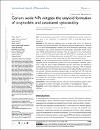Cerium oxide NPs mitigate the amyloid formation of α-synuclein and associated cytotoxicity
| Author | Zand Z. |
| Author | Khaki P.A. |
| Author | Salihi A. |
| Author | Sharifi M. |
| Author | Nanakali N.M.Q. |
| Author | Alasady A.A.B. |
| Author | Aziz F.M. |
| Author | Shahpasand K. |
| Author | Hasan, Anwarul |
| Author | Falahati M. |
| Available date | 2022-05-21T10:18:33Z |
| Publication Date | 2019 |
| Publication Name | International Journal of Nanomedicine |
| Resource | Scopus |
| Identifier | http://dx.doi.org/10.2147/IJN.S220380 |
| Abstract | Aim: Among therapeutic proposals for amyloid-associated disorders, special attention has been given to the exploitation of nanoparticles (NPs) as promising agents against aggregation. Methods: In this paper, the inhibitory effect of cerium oxide (CeO2) NPs against a- synuclein (a-syn) amyloid formation was explored by different methods such as Thioflavin T (ThT) and 8-anilinonaphthalene-1-sulfonic acid (ANS) fluorescence spectroscopy, Congo red adsorption assay, circular dichroism (CD) spectroscopy, transmission electron microscopy (TEM), and bioinformatical approaches. Also, the cytotoxicity of a-syn amyloid either alone or with CeO2 NPs against neuron-like cells (SH-SY5Y) was examined using 3-(4,5- dimethylthiazol-2-yl)-2,5-diphenyltetrazolium bromide (MTT), flow cytometry, and quantitative real-time polymerase chain reaction (Bax and Bcl-2 gene expression) assays. Results: ThT and ANS fluorescence assays indicated that CeO2 NPs inhibit the formation of aggregated species and hydrophobic patches of a-syn in amyloidogenic conditions, respectively. Congo red and CD assays demonstrated that CeO2 NPs reduce the formation of amyloid species and ?-sheets structures of a-syn molecules, respectively. TEM investigation also confirmed that CeO2 NPs limited the formation of well-defined fibrillary structures of a- syn molecules. Molecular docking and dynamic studies revealed that CeO2 NPs could bind with different affinities to a-syn monomer and amyloid species and fibrillar structure of a-syn is disaggregated in the presence of CeO2 NPs. Moreover, cellular assays depicted that CeO2 NPs mitigate the cell mortality, apoptosis, and the ratio of Bax/Bcl-2 gene expression associated with a-syn amyloids. Conclusion: It may be concluded that CeO2 NPs can be used as therapeutic agents to reduce the aggregation of proteins and mitigate the occurrence of neurodegenerative diseases. |
| Language | en |
| Publisher | Dove Medical Press Ltd. |
| Subject | Amyloid Cellular assay Cerium oxide Cytotoxicity Inhibition Nanoparticle Spectroscopy |
| Type | Article |
| Volume Number | 14 |
Files in this item
This item appears in the following Collection(s)
-
Mechanical & Industrial Engineering [1252 items ]


